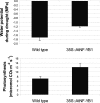Plant nuclear factor Y (NF-Y) B subunits confer drought tolerance and lead to improved corn yields on water-limited acres
- PMID: 17923671
- PMCID: PMC2034233
- DOI: 10.1073/pnas.0707193104
Plant nuclear factor Y (NF-Y) B subunits confer drought tolerance and lead to improved corn yields on water-limited acres
Abstract
Commercially improved crop performance under drought conditions has been challenging because of the complexity of the trait and the multitude of factors that influence yield. Here we report the results of a functional genomics approach that identified a transcription factor from the nuclear factor Y (NF-Y) family, AtNF-YB1, which acts through a previously undescribed mechanism to confer improved performance in Arabidopsis under drought conditions. An orthologous maize transcription factor, ZmNF-YB2, is shown to have an equivalent activity. Under water-limited conditions, transgenic maize plants with increased ZmNF-YB2 expression show tolerance to drought based on the responses of a number of stress-related parameters, including chlorophyll content, stomatal conductance, leaf temperature, reduced wilting, and maintenance of photosynthesis. These stress adaptations contribute to a grain yield advantage to maize under water-limited environments. The application of this technology has the potential to significantly impact maize production systems that experience drought.
Conflict of interest statement
The authors declare no conflict of interest.
Figures






References
MeSH terms
Substances
Associated data
- Actions
- Actions
LinkOut - more resources
Full Text Sources
Other Literature Sources
Medical
Molecular Biology Databases

